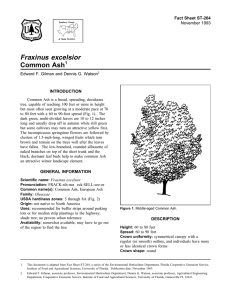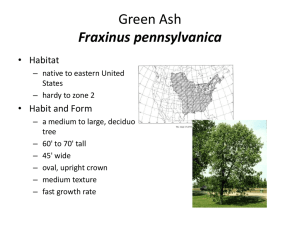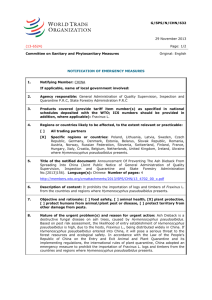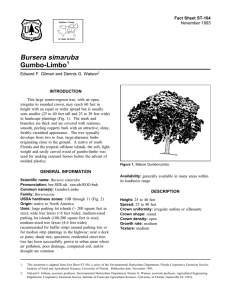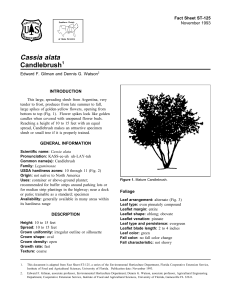Fraxinus velutina Velvet Ash Fact Sheet ST-271 1
advertisement
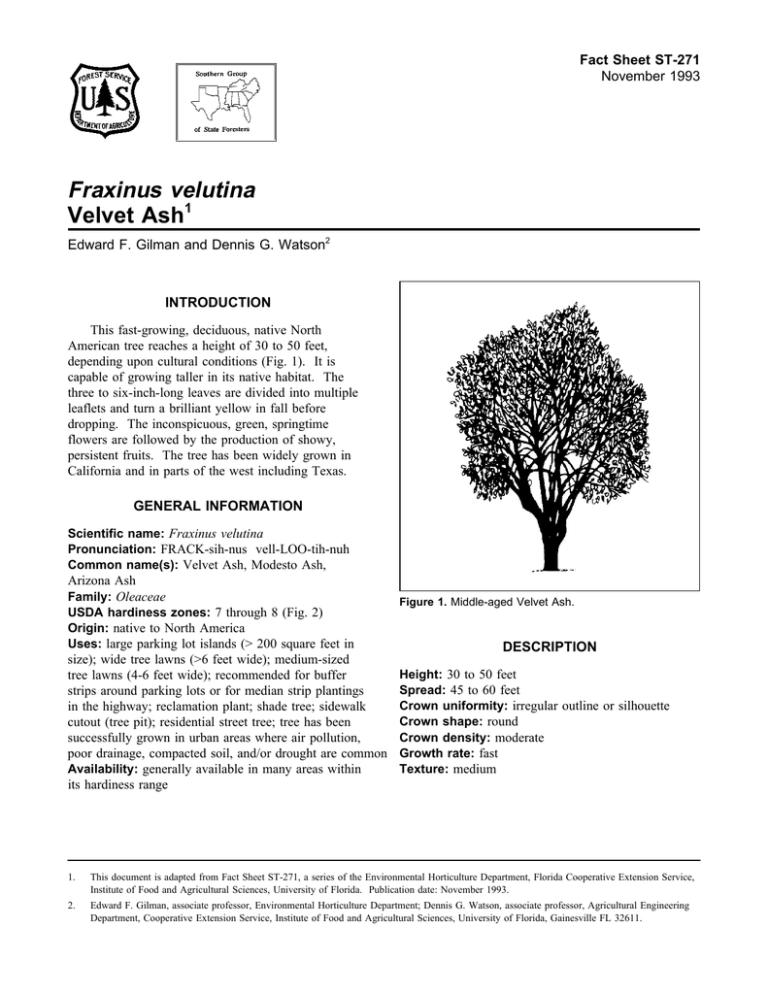
Fact Sheet ST-271 November 1993 Fraxinus velutina Velvet Ash1 Edward F. Gilman and Dennis G. Watson2 INTRODUCTION This fast-growing, deciduous, native North American tree reaches a height of 30 to 50 feet, depending upon cultural conditions (Fig. 1). It is capable of growing taller in its native habitat. The three to six-inch-long leaves are divided into multiple leaflets and turn a brilliant yellow in fall before dropping. The inconspicuous, green, springtime flowers are followed by the production of showy, persistent fruits. The tree has been widely grown in California and in parts of the west including Texas. GENERAL INFORMATION Scientific name: Fraxinus velutina Pronunciation: FRACK-sih-nus vell-LOO-tih-nuh Common name(s): Velvet Ash, Modesto Ash, Arizona Ash Family: Oleaceae USDA hardiness zones: 7 through 8 (Fig. 2) Origin: native to North America Uses: large parking lot islands (> 200 square feet in size); wide tree lawns (>6 feet wide); medium-sized tree lawns (4-6 feet wide); recommended for buffer strips around parking lots or for median strip plantings in the highway; reclamation plant; shade tree; sidewalk cutout (tree pit); residential street tree; tree has been successfully grown in urban areas where air pollution, poor drainage, compacted soil, and/or drought are common Availability: generally available in many areas within its hardiness range Figure 1. Middle-aged Velvet Ash. DESCRIPTION Height: 30 to 50 feet Spread: 45 to 60 feet Crown uniformity: irregular outline or silhouette Crown shape: round Crown density: moderate Growth rate: fast Texture: medium 1. This document is adapted from Fact Sheet ST-271, a series of the Environmental Horticulture Department, Florida Cooperative Extension Service, Institute of Food and Agricultural Sciences, University of Florida. Publication date: November 1993. 2. Edward F. Gilman, associate professor, Environmental Horticulture Department; Dennis G. Watson, associate professor, Agricultural Engineering Department, Cooperative Extension Service, Institute of Food and Agricultural Sciences, University of Florida, Gainesville FL 32611. Fraxinus velutina -- Velvet Ash Page 2 Figure 2. Shaded area represents potential planting range. Foliage Leaf arrangement: opposite/subopposite Leaf type: odd pinnately compound Leaflet margin: serrate Leaflet shape: elliptic (oval); lanceolate Leaflet venation: pinnate Leaf type and persistence: deciduous Leaflet blade length: 2 to 4 inches; less than 2 inches Leaf color: green Fall color: yellow Fall characteristic: showy Flower Flower color: green Flower characteristics: inconspicuous and not showy; spring flowering Fruit characteristics: does not attract wildlife; fruit, twigs, or foliage cause significant litter; persistent on the tree; showy Trunk and Branches Trunk/bark/branches: grow mostly upright and will not droop; not particularly showy; should be grown with a single leader; no thorns Pruning requirement: requires pruning to develop strong structure Breakage: susceptible to breakage either at the crotch due to poor collar formation, or the wood itself is weak and tends to break Current year twig color: gray Current year twig thickness: medium; thick Culture Light requirement: tree grows in full sun Soil tolerances: clay; loam; sand; acidic; Fruit occasionally wet; alkaline; well-drained Fruit Fruit Fruit Fruit shape: elongated length: .5 to 1 inch covering: dry or hard color: green; tan Drought tolerance: high Fraxinus velutina -- Velvet Ash Other Roots: surface roots are usually not a problem Winter interest: no special winter interest Outstanding tree: not particularly outstanding Invasive potential: little, if any, potential at this time Ozone sensitivity: tolerant Verticillium wilt susceptibility: susceptible Pest resistance: very sensitive to one or more pests or diseases which can affect tree health or aesthetics USE AND MANAGEMENT The tree has been traditionally difficult to maintain due to the development of many upright trunks originating from the same position on the main trunk. This condition has lead to the creation of weak trees which often break apart at the base of the multiple trunks. Careful pruning and branch selection is required during the first 15 years after planting to ensure good, strong trunk and branch development. It is important to purchase good quality planting stock which has a central leader and no upright multiple trunks. This will make the tree much easier to maintain in the landscape. Some horticulturists do not recommend planting this tree due to the high pruning requirement and susceptibility to breakage. Velvet Ash should be grown in full sun on any soil and will tolerate both alkaline and rocky soils. It is tolerant of wet soil and has been extensively used along streets in areas with poor drainage. Roots often grow close to the soil surface causing a nuisance by breaking sidewalks and curbs. The cultivar ‘Arizona’ is widely planted but reportedly has the same problems as the species. Propagation is easily done by seed. Pests It is very susceptible to borers. Trees often have a short-life. Diseases Texas Ash is susceptible to verticillium wilt. Page 3

